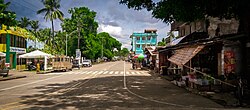Silago | |
|---|---|
| Municipality of Silago | |
 View of Silago | |
| Anthem: Silago Hymn | |
 Map of Southern Leyte with Silago highlighted | |
Location within the Philippines | |
| Coordinates: 10°31′45″N125°09′42″E / 10.5291°N 125.1618°E | |
| Country | Philippines |
| Region | Eastern Visayas |
| Province | Southern Leyte |
| District | 2nd district |
| Founded | June 20, 1950 |
| Barangays | 15 (see Barangays) |
| Government | |
| • Type | Sangguniang Bayan |
| • Mayor | Lemuel P. Honor (PROMDI) |
| • Vice Mayor | Sandielito A. Ando (PROMDI) |
| • Representative | Christopherson M. Yap |
| • Municipal Council | Members |
| • Electorate | 10,957 voters (2025) |
| Area | |
• Total | 215.05 km2 (83.03 sq mi) |
| Elevation | 150 m (490 ft) |
| Highest elevation | 909 m (2,982 ft) |
| Lowest elevation | 0 m (0 ft) |
| Population (2024 census) [3] | |
• Total | 14,677 |
| • Density | 68/km2 (180/sq mi) |
| • Households | 3,345 |
| Economy | |
| • Income class | 4th municipal income class |
| • Poverty incidence | 22.15 |
| • Revenue | ₱ 150.2 million (2022) |
| • Assets | ₱ 323.4 million (2022) |
| • Expenditure | ₱ 111.1 million (2022) |
| • Liabilities | ₱ 43.15 million (2022) |
| Service provider | |
| • Electricity | Southern Leyte Electric Cooperative (SOLECO) |
| Time zone | UTC+8 (PST) |
| ZIP code | 6606 |
| PSGC | |
| IDD : area code | +63 (0)53 |
| Native languages | Boholano dialect Cebuano Tagalog |
Silago, officially the Municipality of Silago (Cebuano : Lungsod sa Silago; Tagalog : Bayan ng Silago), is a municipality in the province of Southern Leyte, Philippines. According to the 2020 census, it has a population of 13,116 people. It was used to be barrio of Hinunangan until Executive Order No. 326 dated May 17, 1950 [5] separated it from the mother town. The town has an ebony beach with unique black sand. [6]




